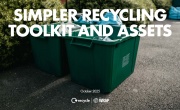Report outlines circular strategy for critical raw materials
The Green Alliance has published a report which argues that the UK’s critical minerals strategy must consider implementing circular strategies in its handling of raw materials through enforcing recycling and reuse measures.
The body states that the Government must avoid focussing simply on securing supply chains within the strategy, slated to be published in 2022, instead holding additional consideration for means through which to keep resources within the UK economy for longer. Scaling up the circular economy for minerals is advocated throughout the report, which also analyses the demand for critical raw materials – such as lithium and cobalt – and asserts that the usage of such could be halved by 2035 were the UK to reduce demand for energy.
 Critical point: securing the raw materials needed for the UK's green transition, forms part of the work programme of the Green Alliance’s Circular Economy Task Force, a forum for ‘policy, innovation, and business thinking on resource use in the UK.’ It argues that whilst ‘higher product standards and recycling measures’ are essential for transitioning into a circular economy, the Government cannot tackle the national waste problem without ‘clear target to reduce resource use itself.’
Critical point: securing the raw materials needed for the UK's green transition, forms part of the work programme of the Green Alliance’s Circular Economy Task Force, a forum for ‘policy, innovation, and business thinking on resource use in the UK.’ It argues that whilst ‘higher product standards and recycling measures’ are essential for transitioning into a circular economy, the Government cannot tackle the national waste problem without ‘clear target to reduce resource use itself.’
The findings of the report
The report prefaces that the transition towards a net-zero society is threatened by supply chain risks surrounding critical raw materials. At the same time, it states that the transition itself could result in the UK using double its global fair share of certain natural resources by 2030, which could increase to as much as five times its share by 2050, due to the use of elements such as lithium and cobalt in renewable energy infrastructure.
Beyond simple energy-saving measures, the report promotes the scaling up of recovery and reprocessing in order to meet demand for critical raw materials with secondary resources.
Focussing on the circular economy proposal, the following appeals are made within the report:
- The Government should introduce an effective extended producer responsibility (EPR) framework for batteries, as well as waste electrical and electronic equipment (WEEE)
- The standard of end of life treatment for low carbon technologies should be improved, with recycled content quotas being increased
- In terms of electric vehicle batteries, comprehensive circular economic policy should be established in order to spur investment in reprocessing
- The UK Infrastructure Bank should invest in circular infrastructure, including ‘recovery, reprocessing and reuse facilities for critical raw materials and the technologies which require them, and in adequate storage facilities to retain value’
Recovery and recycling is advocated as an effective practice throughout the report. It estimates that if the 1,400 tonnes of lithium and 800 tonnes of cobalt contained within the UK’s fleet of electric fleet of vehicles (as of 2019) were all recovered and recycled, there would be enough acquired raw material to produce 222,000 car batteries – this equates to 10 per cent of projected new sales in 2035. Furthermore, if recycling rates were to reach 70 per cent for lithium, 80 per cent for rare earths, and 90 per cent for cobalt by 2050, nearly all critical material needs could be met by the obtained matter for the UK’s wind, solar and electric vehicle infrastructure.
The publication highlights that the UK has work to do in the field, pointing out where it may potentially be lagging behind the rest of the world. In the EU, for example, action is already being taken to encourage the circularity of critical raw materials with the introduction of the Action Plan on Critical Raw Materials. Working with the European Raw Materials Alliance, the scheme ‘commits to mapping secondary supplies of critical raw materials and identifying sites for recycling by 2022.’ In tandem with this, the EU has drafted its proposed Sustainable Battery Regulations that will see legal requirements introduced that enforce the circularity of critical raw materials used within batteries.








